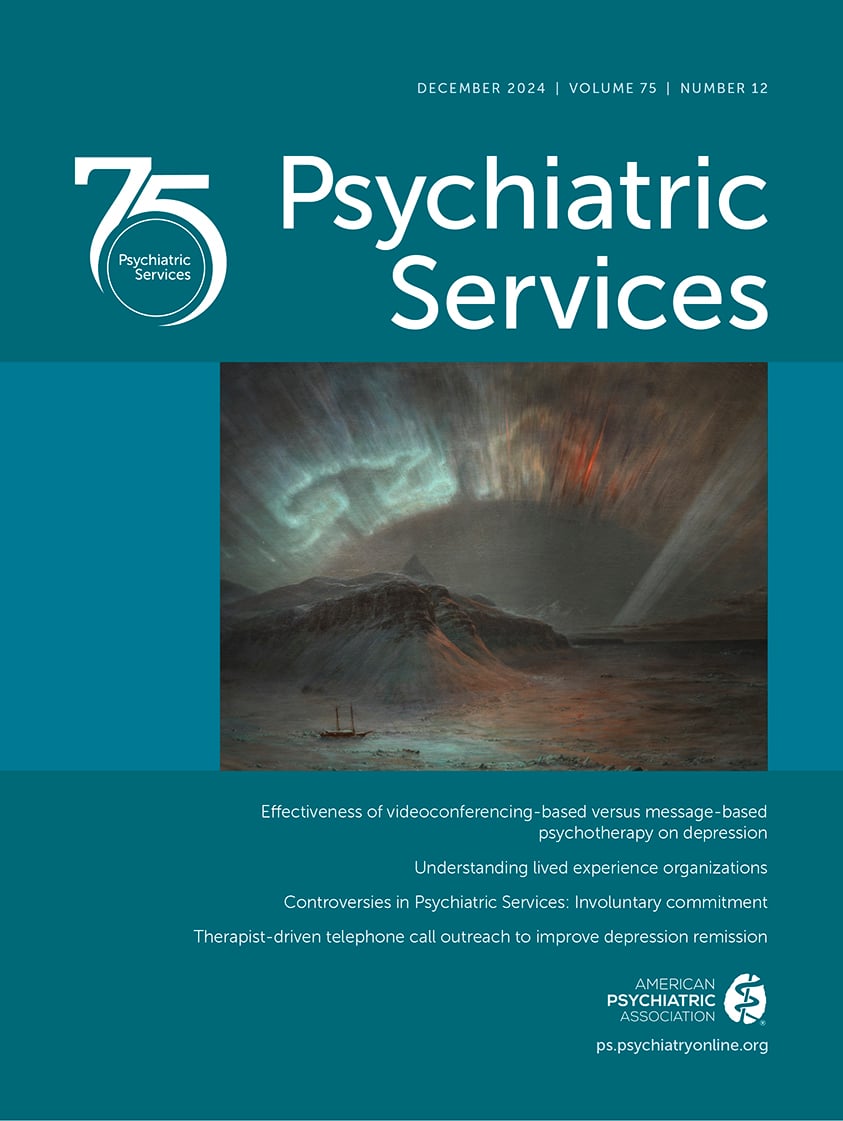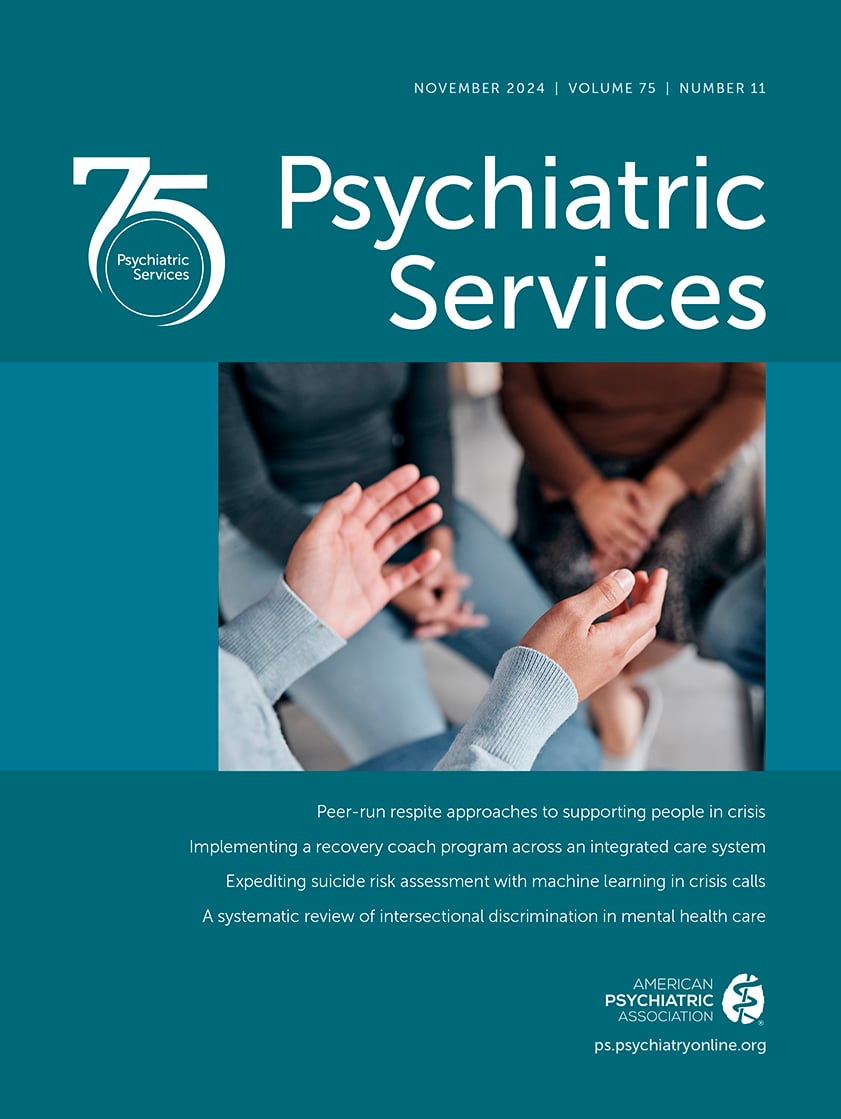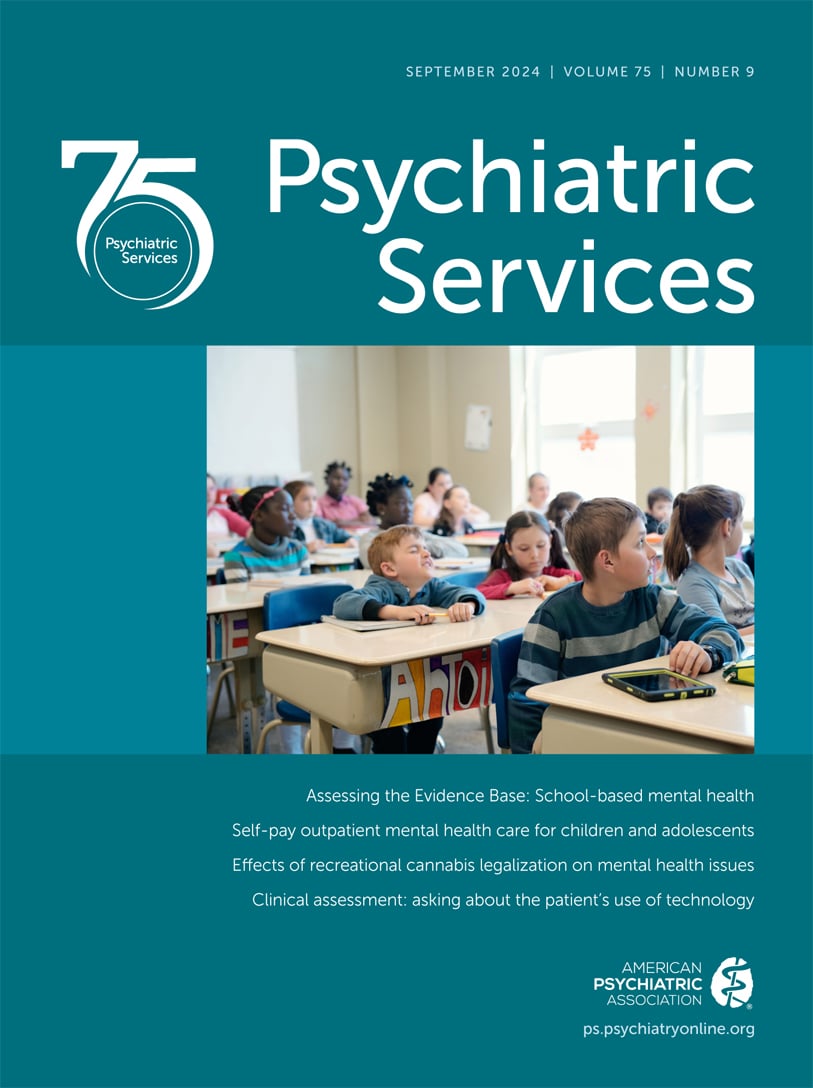Psychiatric Services
- Volume 74
- Number 8
- August 2023
Taking Issue
Articles
Publication date: 31 January 2023
Pages790–800Objective: This work aimed to assess the therapeutic and economic benefits of service dogs versus emotional support dogs for veterans with posttraumatic stress disorder (PTSD). Methods: Veterans with PTSD (N=227) participating in a multicenter trial were ...
https://doi.org/10.1176/appi.ps.20220138Publication date: 05 April 2023
Pages801–808Objective: This study examined time trends and patient characteristics related to guideline-recommended cardiometabolic risk factor monitoring among youths treated with antipsychotic medications. Methods: This observational study assessed participant ...
https://doi.org/10.1176/appi.ps.20220151Publication date: 06 March 2023
Pages809–815Objective: Military personnel frequently report discontinuing or not pursuing psychiatric treatment despite perceiving a need for services. This study aimed to examine how unmet need for treatment or support among U.S. Army soldiers relates to future ...
https://doi.org/10.1176/appi.ps.20220248Publication date: 15 February 2023
Pages816–822Objective: Dual Eligible Special Needs Plans (D-SNPs) are a type of Medicare Advantage (MA) plan for individuals who have both Medicare and Medicaid coverage. The authors compared the breadths of psychiatrist and nonpsychiatrist provider networks in D-SNPs ...
https://doi.org/10.1176/appi.ps.20220239Publication date: 23 February 2023
Pages823–829Objective: Financial incentives can facilitate behavior change and service engagement in health care settings, but research on their use with adults experiencing homelessness is limited. This study examined the effectiveness of financial incentives in ...
https://doi.org/10.1176/appi.ps.20220392Publication date: 15 February 2023
Pages830–837Objective: Co-occurrence of substance use disorder and mental illness complicates treatment and is associated with increased disability. However, identification of substance use disorder in populations recently engaged in treatment can be challenging. This ...
https://doi.org/10.1176/appi.ps.20220343Reviews & Overviews
Publication date: 29 March 2023
Pages838–846In recent years, psychedelic-assisted psychotherapies have reentered the realm of rigorous scientific inquiry, garnering much attention from both the psychiatric community and the broader public. Headlines on major media platforms frequently tout the ...
https://doi.org/10.1176/appi.ps.20220525Publication date: 08 February 2023
Pages847–858Objective: Peer support has been shown to support personal recovery from mental illness. It is unclear whether the effects of peer support across different mental illnesses depend on the organizational setting. The authors reviewed the effectiveness of ...
https://doi.org/10.1176/appi.ps.202100138Publication date: 15 February 2023
Pages859–868Objective: The authors of this systematic review examined service utilization and outcomes among youths from ethnoracially minoritized groups after the youths initiated treatment for a psychotic disorder—that is, the youths’ “pathway through care.” Also ...
https://doi.org/10.1176/appi.ps.20220121Special Articles
Publication date: 13 December 2022
Pages869–875The DSM-5 text revision (DSM-5-TR) is the first published revision of the DSM-5 since its publication in 2013. Like the previous text revision (DSM-IV-TR), the main goal of the DSM-5-TR is to comprehensively update the descriptive text accompanying each ...
https://doi.org/10.1176/appi.ps.20220334Brief Reports
Publication date: 22 December 2022
Pages876–879Objective: The authors sought to determine whether providing summaries of patients’ social media and other digital data to patients and their clinicians improves patients’ health-related quality of life (HRQoL) measured by the RAND 36-Item Short Form ...
https://doi.org/10.1176/appi.ps.20220272Publication date: 08 February 2023
Pages880–884Objective: This study examined trends and geographic variability in dispensing of prescription psychotropic medications to U.S. youths before and after the start of the COVID-19 pandemic. Methods: Using national data on prescription medication dispensing, ...
https://doi.org/10.1176/appi.ps.20220314Publication date: 23 February 2023
Pages885–888Objective: The authors compared rates of in-home, natural death among individuals receiving treatment for mental illnesses with those in the general population. Methods: Two data sets were used to determine the prevalence of in-home, natural deaths in the ...
https://doi.org/10.1176/appi.ps.202100732Open Forum
Publication date: 31 January 2023
Pages889–891Recent implementation of the nationwide 988 Suicide and Crisis Lifeline has expanded telephone-based mental health crisis services and created a unified framework for crisis care in the United States. However, the infrastructure for the final step of the ...
https://doi.org/10.1176/appi.ps.20220503Personal Accounts
Promoting High-Value Mental Health Care
Publication date: 25 January 2023
Pages894–897In recent years, coordinated specialty care (CSC) providers have worked to harmonize and deliver data collection measures across programs so that they can provide data that enable measurement-informed care. However, the strategies that can effectively ...
https://doi.org/10.1176/appi.ps.20220419Past Issues
View Issues Archive
Vol. 75 | No. 12

Vol. 75 | No. 11

Vol. 75 | No. 10
